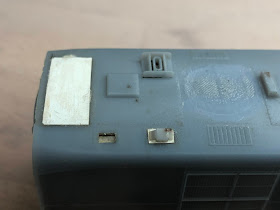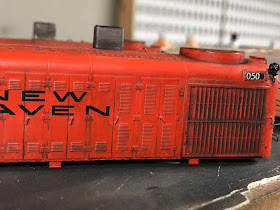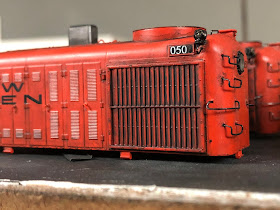OK, I won't be getting to finishing these yet, but in response to a recent Facebook post and to help a modeling buddy, here's some detailed info on these locomotives and what I'm doing to model them.
DER-1 (DL-109) 0703 on train 136 at New Britain Station. Kent Cochrane c.1945.
The DER-1 locomotives were built for the NH starting in 1941. While there were 74 closely related locomotives built by Alco between 1939 and 1945 of the models DL-103b, 105, 107, and 109 (along with B-unit models DL-108 and 110), only 62 of model DL-109 were built, and 60 of those were for the New Haven Railroad.
I've been compiling information and documenting photos for an eventual Shoreliner article (by me, or anybody who would like help writing it). The information I've been able to glean is a little different from what's been published to date.
The New Haven simply called them by their road numbers (the 0700s) until 1944 when a new classification system was introduced at which point the DL-109s were designated DER-1 locomotives with the following sub classifications in the 1945 Description of Locomotives:
- DER-1 - 0700-0709
- DER-1a - 0710-0719
- DER-1b - 0720-0729
- DER-1c - 0730-0759
Between the 3/30 and 6/30 1949 Summary of Equipment documents the classifications changed:
- DER-1a 0700-0709
- DER-1b 0710-0749
- DER-1c 0750-0759
However, the 1949-1951 engine assignments differ and list them as:
- DER-1 - 0700-0709
- DER-1a - 0710-0719
- DER-1b - 0720-0759
But the Summary of Equipment documents classify them as:
- DER-1a - 0700-0709
- DER-1b - 0710-0749
- DER-1c - 0750-0759
So what is different between the classes? That I don't know. I have seen one drawing that identifies the clearance below the frame to be different between the DER-1 and other classes. The weight differs between some of the classes too.
Most of the differences are probably mechanical and not evident to modelers. What has me the most curious is that there were still 3 classes after they were all rebuilt, so obviously some differences remain (although the fact that the post-rebuild classifications are inconsistent between the engine assignments and equipment summaries is curious).
So I'll identify the locomotives by road number, rather than class to keep things simple here. I'm primarily focusing on how I'm modifying the Proto shells, but I'll point out a few issues with the Overland brass models as well. I don't have the Hallmark brass model, but the nose contour was so incorrect it's not one I would use as a base.
I'm not covering converting the Proto model to the rebuilt configuration. Dave Messer wrote an excellent article for Railroad Model Craftsman in the January 2006 issue. Joe Smith has a post about his conversion, which also includes modeling the new nose of 0727 as a B-unit. Of course, the easier option is to use the Overland Brass model, which is what I'm doing.
Roof
The original roofline has a series of vents that are mostly, but not quite, captured by the Proto 1000 model. Good photos that show the roof in detail are rare, unfortunately, so this is what I've been able to figure out. The original 10 locomotives did not have winterization hatches, but they were all added well before my era. Mike Redden updated his excellent Shapeways parts at my request so they now fit over the round fan housing on the model.
Version 1: 0700-0719
Some minor modifications are needed for this class of locomotives. I have not added the winterization hatches yet to these models, the first ten were delivered without them, but all received them long before my era:
There are four small raised vents/intakes (I don't know what they are) in front of each fan housing. Remove the first two by carefully scraping them off with a blade. You want to keep them intact because you'll need one of them. Cover the hole with .005" styrene.
Go easy on the solvent, I used a little too much and the cover deformed a bit.
On the rear of the roof you need to remove the two round protrusions, then add another cover the same width as the existing one with .005" styrene:
I could have sworn I took a picture cutting off the round parts, but I can't find it right now. On the lower picture, I tried embossing rivets (a Joe Smith technique) by putting the .005" styrene over a line of rivets somewhere else on the model, but it didn't work very well for me. You'll also see that I removed the small vent/intake, and used some .005" styrene to create a base to remount one of them a little father forward. On one shell I added styrene underneath the hole, the other shell I've left open.
You'll notice on one of the shells I removed the fan housings. I was using Mike's older winterization hatches which required that. I may drill them out because the new ones are see-through.
There are at least four lift rings yet to be added, on the large panels near the fan housings. I'm still trying to determine if there were more. There are some other details (mushroom-shaped vents on the roof just behind the side doors, as well as some sort of vent that angles toward the back near each fan housing. I'm still looking for better photos of those. I'm also not 100% clear about the arrangement of the final roof panels behind the second fan housing.
This roofline is correct for the first 20 units (0700-0719). Much of what has been published indicates the second group (0710-0719) had a simplified roof line, but pictures verify they were the same.
Overland 6312 labeled for 0700-0709 is appropriate for all 20 of these locomotives.
Overland 1993 is labeled as a DER-1b for 0710-0749, but is actually appropriate at least for 0750-0759, and potentially for 0739-0759.
Version 2: 0720-0729(?)
I haven't attempted to model any of these locomotives, but they require more extensive roof modifications.
First, not only are all four of the vents/intakes in front of the radiator fans not present, it is just the two large panels, with no indication they were there. So instead of covering up the location of two of them, you'll need to remove all four in each section, then fill and file the whole panel so it is smooth (except for the rivets around the outside of course).
The two scoops next to this panel also need to be removed, as does the mushroom vent above the fireman's and engineer's windows.
Next to each radiator fan there are two vents molded into roof. Those need to be filed away and replaced with a drop grab.
Version 3: 0730(?)-0759
The earliest road number I've documented with these modifications is 0735. The major difference is the two globe vents in each of those large panels in front of the fan housings/winterization hatches. It appears some of the units had the globe vents removed at some point.
Sides
There are louvres on the side under the first and last windows on the right side, and in the same location on the left side, ignoring the extra window behind the radiator shutters.
Version 1 (0700-0719)
There is a pair of louvres.
Version 2 (0720-0759)
On later units there are three louvres, but...
A photo of 0720 in New Haven Diesel Locomotives Volume 2, it has only a pair of louvres in the delivery scheme. (There is a photo on pg 16 that says it is 0735 that also has two louvres, but the caption is wrong. It has to be 0700-0719 based on the roofline). So I'm not sure how many of this class had two, rather than three louvres.
The other variation is how visible the two vertical lines of rivets between side panels are. In some photos they are very evident, others they seem to be non-existent.
Trucks
There are two variations of the trucks, with noticeable flanges along the equalizers on one variation. There really isn't much option other than modifying the model trucks. But photos also show that the trucks seem to have been switched among locomotives, with the same road number being photographed with either, and in some cases, one of each. I will look closer at these details when I get to that point.
Pilot Details
The cut out for the coupler is oversized. I addressed this by first gluing a piece of thin styrene behind it, covering the entire hole. I then filled the actual hole with several strips of styrene and filed to shape before cutting out a new hole.



I still need to add the small steps at the corners of the pilot, along with the grab irons. This will be 0703 so it doesn't need the air intakes (see below).
There were also two different types of number boards, the original cast ones, and (starting with 0730?) later 'built-up' ones. I haven't determined if/how I will address this.
Air Intakes
0700-0719 lacked the small square air intakes on the nose that are on the later locomotives.
Decorative Flair
The nose of most of the locomotives had a curved flair that lead into the original striping on the nose. However, like so many things with these locomotives, there are some oddities. Initially, I thought it was the last ten (0750-0759) that lacked this decorative touch. Then I find a photo of 0750 with it after the rebuild. Also after the rebuild, 0739 is clearly lacking it, although 0738 and 0740 both have it.
Paint Schemes
In the post-war era, the DL-109s were repainted in several different schemes. I've been working to document each road number that wore each scheme based primarily on photos, but also what little documentation we've been able to find. I've noted the date of the documented photo where known.
Delivery Scheme
There are a couple of locomotives that appear to have retained their delivery scheme possibly until they were rebuilt. For a stretch, though, they didn't apply a road number to the nose so in many photos you can't determine the road number.
These are locomotives that I haven't documented in another paint scheme, or the latest year noted that I have seen a photo in the delivery scheme, to give some context for a later scheme:
0710
0715
0717 (1946 - although see below for the Hunter Green and Warm Orange scheme)
0718
0722
0723 (1947)
0725-0726
0727 (1948)
0730 (1947)
0731-0734
0735 (1946)
0736-0737
Hunter Green with Wide Silver Gray Stripes
This was an early pinstripe variation c1944. Only a few have been documented in this scheme, with a color photo of two unknown road numbers in New Haven in Color Volume 1 (Doughty):
Hunter Green with Pinstripes
There are two variations of this scheme, one with Imitation Gold pinstripes, and the other with silver gray pinstripes. The pinstripe scheme itself was first applied c1945, but which one? It is unclear as to when each variation was applied, and the published material is inconsistent.
The photo of 0748 in the centerfold of Shoreliner 18.1 looks a lot like Pullman Green with Imitation Gold pinstripes. This would be consistent with the other schemes utilizing Imitation Gold, but some of the other color photos look more like Hunter Green.
The photos don't really clarify things, though. All of the photos with Imitation Gold are 0749 or lower, and the majority of color photos of the silver gray are 0752 or higher. This might lead one to believe that the Imitation Gold was the earlier scheme applied to the earliest locomotives built in 1945 (0739-0749), and silver gray to the final 10.
But we have an undated photo also found in Doughty's book of 0747 in the silver gray pinstripes (we also have one of 0745 in silver gray), and a 1949 photo by John Wallace of the same locomotive in Imitation gold. It wouldn't have been repainted later in '49 without being rebuilt, so the silver gray must have been the earlier one on this locomotive. I know John personally, so I don't doubt the veracity of his date. So the mystery remains.
The only thing I can say is that no color photo of a DL-109 higher than 0749 has surfaced with Imitation Gold pinstripes, and I think it's clear based on the Alco builder's photos that the locomotives built in 1945 were delivered in pinstripes, although I haven't found a photo of 0739 yet.
Suffice to say, I would rely on photos for this scheme in particular. For my model of 0703 based on a 1946 black & white photo, assuming it was repainted c1945 (since the CT Hat Company in the photo is gone by 1946). I'm going with the silver gray because I think it was more common, and I like it better. But it very well may have been gold...
Verified with Imitation Gold pinstripes
0701 (c1947)
0702
0720
0740
0747 (1949)
0748
0749
Verified with Silver Gray pinstripes
0719 (and most probably 0718)
0744
0745-0759 delivered in this scheme
Pinstripes, but color unknown
These are locomotives that have been documented with pinstripes, but only in black & white photos so I don't know which color:
0700
0703 (1946, 1947)
0704 (1946)
0706 (1946)
0724
0743
0744 (1949)
Hunter Green and Warm Orange
A signature scheme, and the delivery scheme of the first delivery of PA-1s along with the FA-1/FB-1 locomotives. Presumably this became the standard at the same time as the FA-1s c1947. Fortunately it's easy enough to pick these out, even in black & white photos.
You may note that most of the first 20 DL-109s were repainted in either pinstripes or the Warm Orange scheme. At least one was repainted in both schemes (0718). This makes sense as they were the earliest DL-109s built and had already logged a lot of miles during WWII. Why some of the later locomotives, including some built in 1945 would have been repainted in this scheme is unknown.
Minor Rebuilds?
What has not been mentioned in any publication that I've seen is that any of the first 20 locomotives (0700-0719) that received this scheme were also modified. When they received this scheme they also received the simplified roofline (version 2) and additional louvres and the nose air intake that were on 0720 and later, although no globe vents.
The earliest locomotives rebuilt with steel sides and screens instead of windows also wore this scheme. I've notated those that have been verified below. This should have included 0740, the first locomotive rebuilt, although it retained its original appearance with windows rather than the screens of all of the other locomotives.
Question marks in the list below denote those that should have received this scheme based on records on when they were repainted, but have yet to be verified by photos. Nearly a third of the DL-109s received this scheme.
0707 (may be 0717, poor scan of photo)
0708
0709
0711
0712
0713
0714
0716
0718
0757
0730
0736
0757
Naturally I would recommend that you model from photos, particularly if you can find one from the era you are modeling. 1949-50 provides the most variations, where all of the following can be found:
- Delivery Scheme
- Hunter Green with Imitation Gold pinstripes
- Hunter Green with Silver Gray pinstripes
- Hunter Green and Warm Orange
- Hunter Green and Warm Orange with rebuilt sides
- Modified Delivery Scheme with rebuilt sides
- Modified Delivery Scheme with road number on nose and windows
- 0722 with rebuilt sides in the Cranberry scheme (after May 18, 1949)
The only schemes not in use during these two years are the wide pinstripes, and the McGinnis scheme that was only applied to 0759 c1955, plus the PP0716.
If you're really ambitious, 0727 received its unfortunate nose-job in 1949, along with 0725 without the drastic modification, to be used as a middle unit on the Merchants Limited and Yankee Clipper. Joe Smith did a fantastic job of modeling 0727.
In my case, I'll be starting with:
- 0700 - assigned to 131/136 post '49, and I know it was rebuilt/repainted in May of '49.
- 0703 - photographed on 131/136 in 1945, I'll use it through '48 in the silver gray pinstripes.
If I get to others, I could use:
- 0707 - also assigned to 131/136 post '49, rebuilt September '49
- 0730 - assigned to 157 in 1949, rebuilt in June '48 so it should be the Hunter Green and Warm Orange.





























































